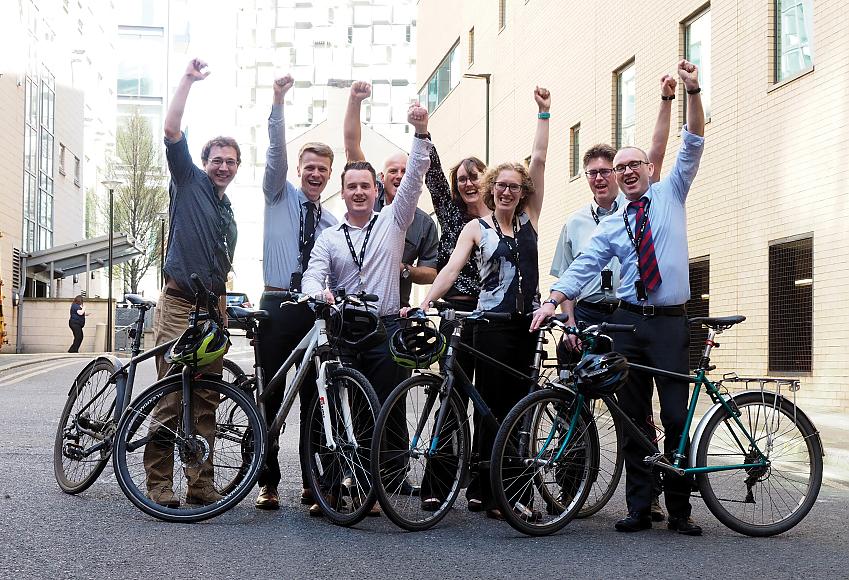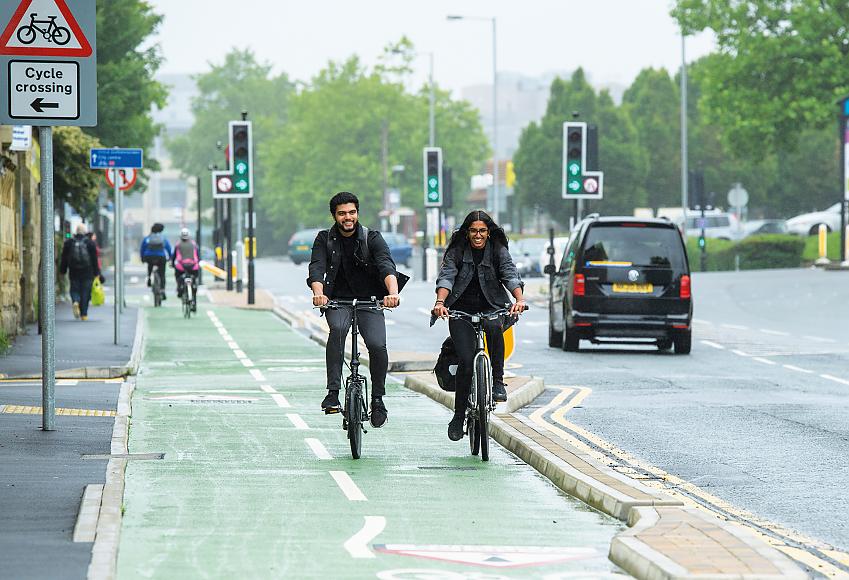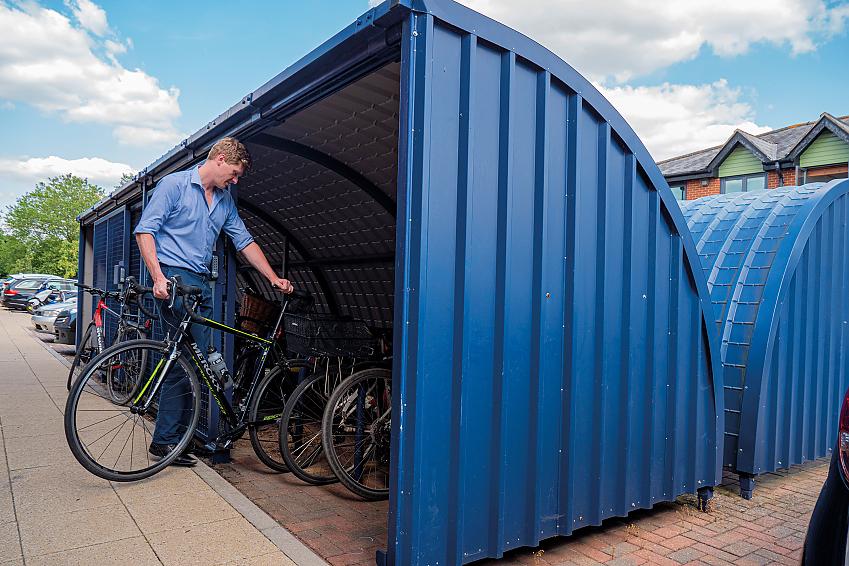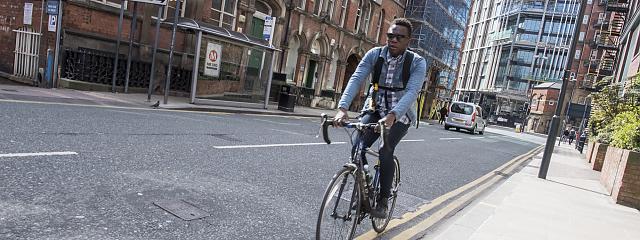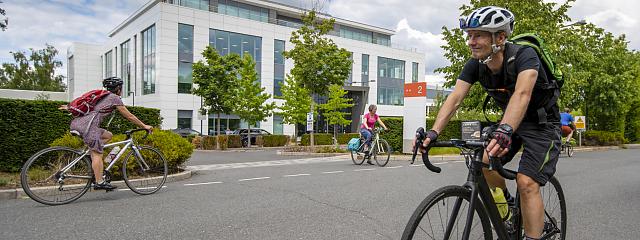How to become a cycle-friendly employer
How to become a cycle-friendly employer
Encouraging cycling helps tackle the business costs of congestion, reduces an organisation's impact on the local and wider environment and even attracts some tax incentives. What's more, it's likely that levels of staff absenteeism will drop.
Never has cycling to work been more important. Not only does it help combat work-related stress, it is also recognised as a safe way travel to work during the pandemic.
Current commuting patterns cost businesses time and money: staff are delayed because of traffic jams; company car-parking spaces are in short supply and mileage costs are rising.
Cycling, however, is often faster than driving - particularly over short distances and when the roads are busy. It's easier for cyclists to bypass traffic jams and they don't need much space at all to park once they arrive at work.
Encouraging employees to cycle to work and for business can result in a healthier, more productive workforce too. It is a known fact that cyclists tend to take fewer days off sick and save a company money.
There are a number of ways in which an employer can become cycle-friendly:
- Communicate regularly with staff about cycling and hold workplace challenges
- Offer a range of tax incentives
- Introduce a ‘green’ travel plan
- Have an office bike, otherwise known as ‘pool’ bikes available
- Provide facilities to support cycling to work such as washing, changing and drying
- Support a cycling group at work or a BUG
- Provide safe, secure and convenient cycle parking facilities
- Become an accredited Cycle Friendly Employer
Keep more staff cycling to work with by holding workplace challenges
Workplace challenges provide an engaging and successful way of promoting and encouraging cycling at your workplace.
- Organisations competing against each other to see who can get most people cycle-commuting.
- Taking part in events such Bike Week or Cycle to Work Day
- Creating a leader board for various cycling related activities
Tax incentives
- Mileage allowance - this is currently 20p a mile for staff using their own cycles whilst on business. As cyclists don't have to buy petrol, their mileage cost of is substantially lower than driving (45p a mile). This makes cycling a real, cost-efficient alternative, particularly over short distances, or in conjunction with travel by public transport for longer journeys.
- The loan of cycles/safety equipment/ (e.g. helmets, reflective clothing, child seats etc);
- The Cycle to Work Scheme, which allows employers to rent cycles for commuting purposes to staff, who then pay less tax.
Our guide to tax incentives goes into more detail.
Encourage your staff to cycle to work by introducing a green travel plan
If you’re looking for some practical measures on how to encourage more people to cycle to work and ride to business meetings check out the Essential Guide to Travel Planning from the Department for Transport.
You can also share Cycling UK’s cycle route planner with your staff.
We have plenty of helpful information and advice.
Having a bike for your workplace
A fleet of cycles, allowing employees to book out a machine for any kind of journey, is a good way of building up a cycling culture at a workplace. It offers staff an efficient, cost effective and convenient transport option, especially for local meetings, travel between sites or lunchtime errands.
Strict health and safety requirements do apply to the provision of pool bikes. Cycle training for staff, insurance and liability issues are discussed in Cycling UK's guide to Pool Bikes.
Installing showers, lockers and drying facilities in the office
Showers help make some people much happier about cycling to work, especially during the summer. Many workplaces already offer showering facilities for their workforce in general, and they also benefit people who jog, go to the gym or exercise during their lunch breaks.
Lockers are useful for storing cycling clothes during the day and in the winter, having somewhere to dry them out after a rainy trip really helps. This facility may be nothing more complex than a dedicated cupboard, with hanging rails and an efficient dehumidifier.
Starting a cycling group at work
Supporting a cycling group at work can really help motivate employees who share an interest in cycling.
In a large organisation, a group might meet regularly to discuss cycling; in a smaller workforce, an email list or dedicated noticeboard might suffice.
Some groups have aims, such as making the workplace more cycle-friendly; others are primarily for socialising or company on the ride home.
Take a look at our useful guide to setting up a cycling group at work.
Cycle parking
Secure and convenient cycle parking at workplaces makes all the difference – and accommodating several cycles is much less costly than providing space for just one car.
Ideally, cycle parking should be near the premises, easy to reach, covered, secure and well designed. If there is nowhere outside to build a shelter, there may be somewhere indoors that could be converted into lockable bike storage. Wall hooks are good space-savers inside or outside.
More information is available in our guide on how to install cycle parking at your workplace.
Want to take the next steps to become a Cycle Friendly Employer?
Being accredited as a Cycle Friendly Employer is a great accolade to have. It demonstrates your commitment to your staff’s health and wellbeing, your consideration of your carbon footprint and makes you more attractive to new employees.
Liability fears
Some employers are reluctant to promote cycling actively because they - or more probably their Health and Safety advisers - are worried about liability issues.
Firstly and most importantly, cycling is not an unduly risky activity – read more in Road Safety and Cycling.
Secondly, Cycling UK argues that it is not the employer who's putting people at the risk by promoting cycling; instead, the threat comes from hostile road conditions (e.g. bad driving, poor infrastructure etc).
In fact, by encouraging cycling rather than driving, employers are making road conditions safer because cyclists do very little harm to other road users.



